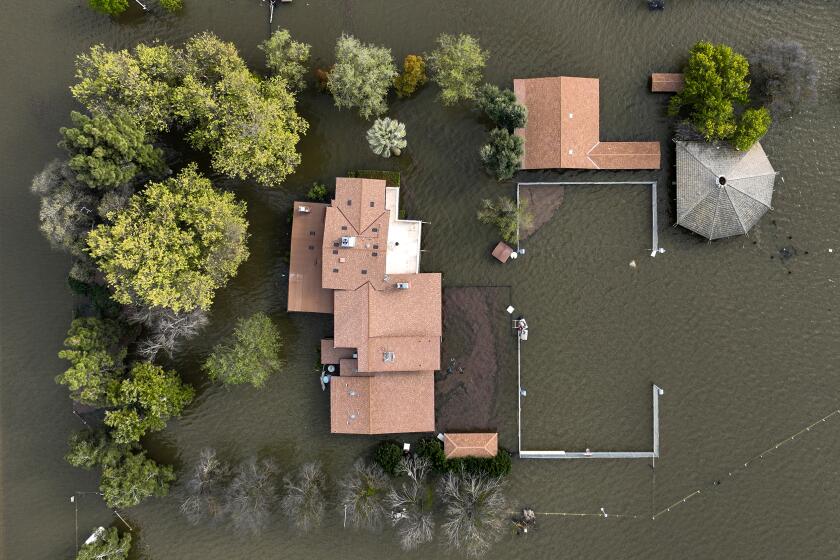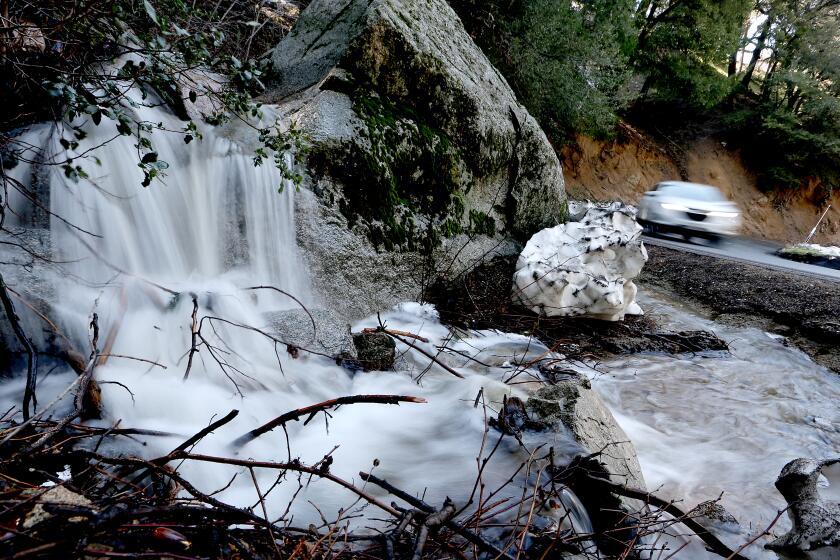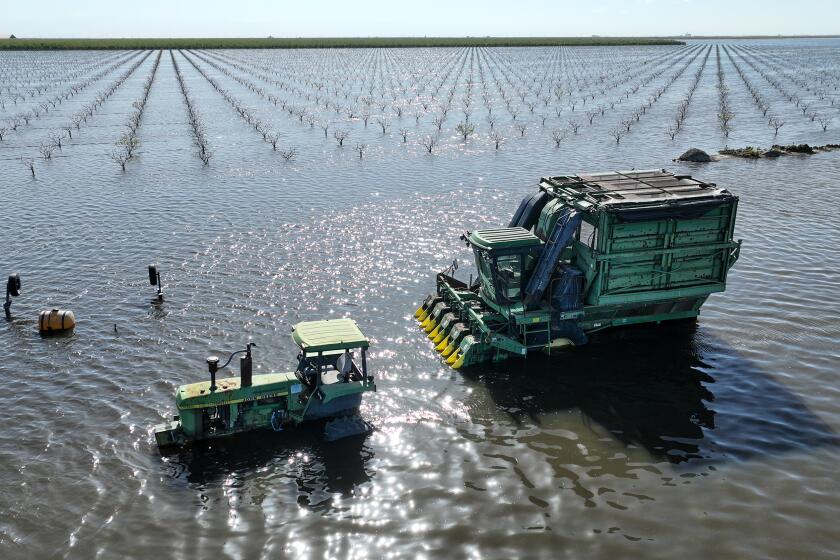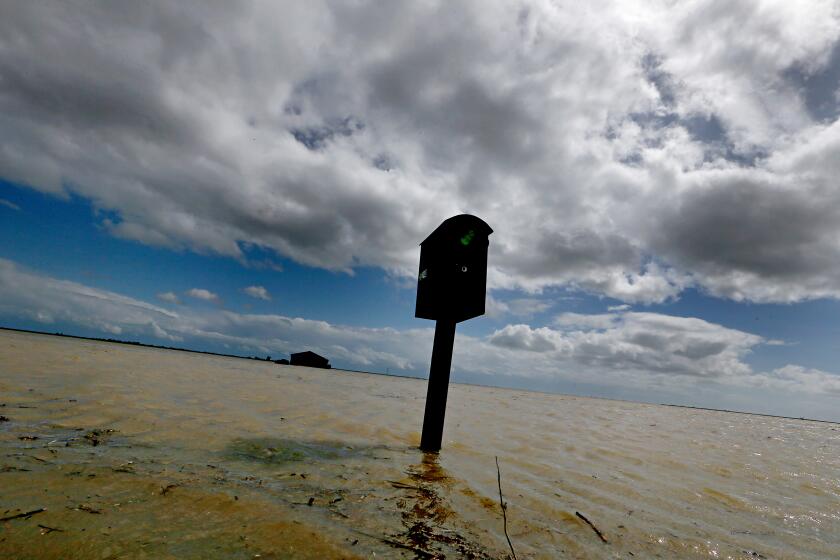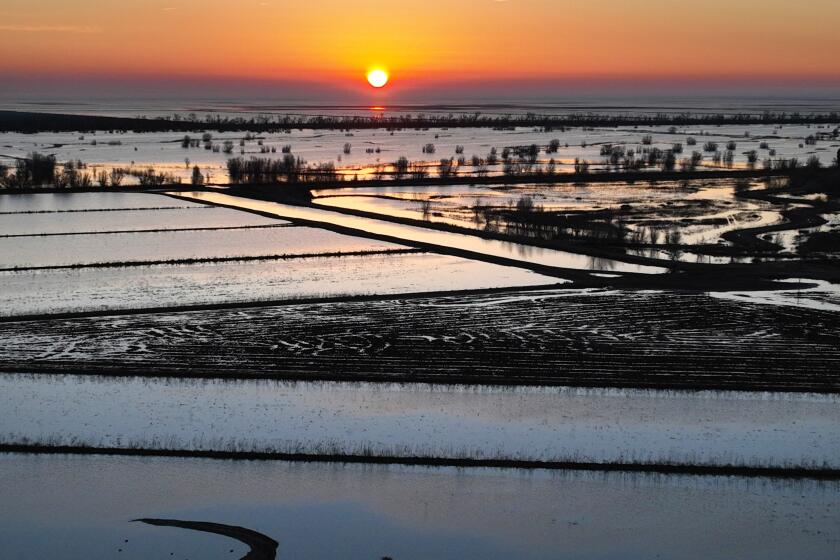A race against time in California town: Floodwaters rising, snow melting, worst still to come
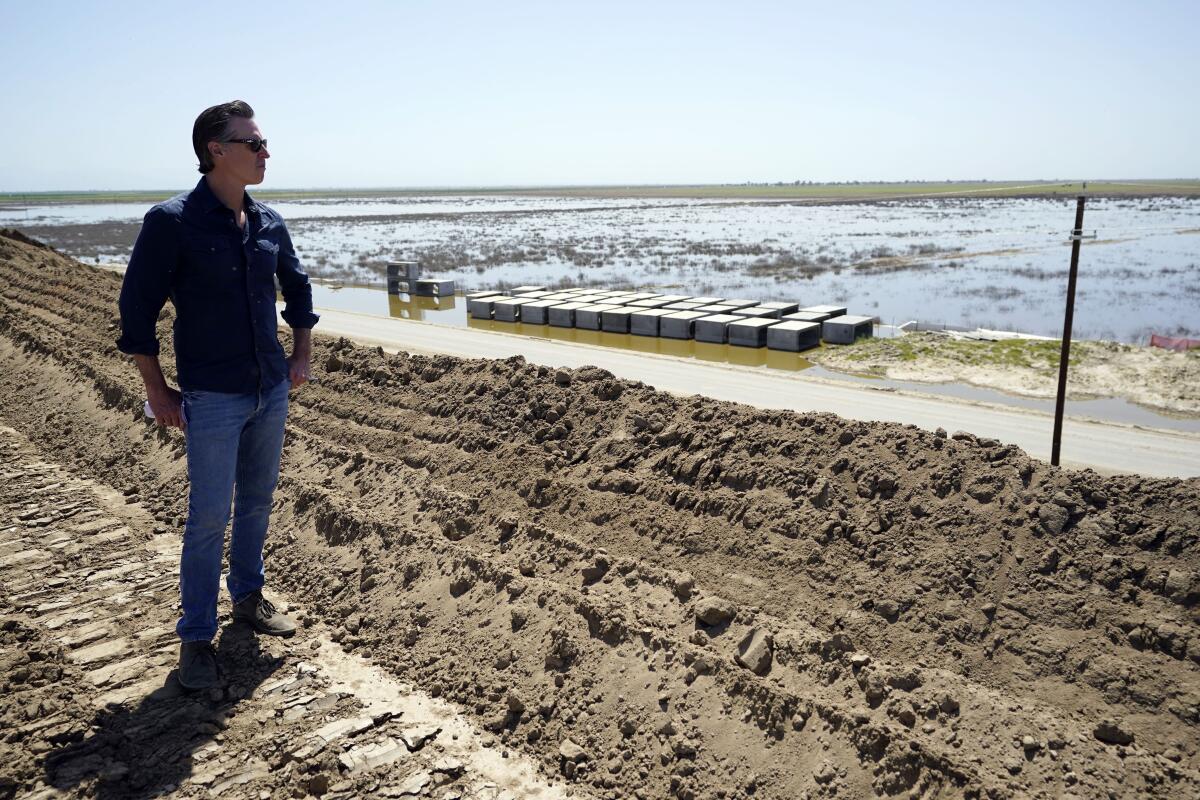
- Share via
CORCORAN, Calif. — Water lapped Tuesday at the edges of 6th Avenue, where thousands of acres of once-fertile farmland sat sodden beneath several feet of stagnant floodwater.
The problem, state officials said, is only going to get worse in the days and weeks to come as temperatures rise and record-deep snowpack in the southern Sierra Nevada begins to melt and make its way downhill.
“You can look at a scene like this and think the worst is going to recede, the worst is behind us, but in fact, quite the contrary,” said Gov. Gavin Newsom, who was visiting Corcoran to survey flood damage from winter storms. In the distance, a farmer steered a boat through the flooded Tulare Lake Basin, which only weeks ago was home to cotton plants, corn, wheat, tomatoes and other crops.
“Every day, you’re seeing an incremental half-inch or inch of more water, new water, present itself here in this basin,” Newsom said. “As a consequence, we not only need to maintain our vigilance, but we can’t be impatient in terms of the impending floods and the damage that will occur here in a very short order.”
Temperatures in the San Joaquin Valley will climb to the high 80s and mid-90s this week, melting deep Sierra snowpack and triggering potential floods.
The flooding that has already occurred was the result of dozens of powerful atmospheric rivers at the start of this year that caused more than $40 million worth of damage in Tulare County alone, said county Supervisor Eddie Valero. Included in that calculation were 50 breached canals, 37 destroyed homes and 13 damaged bridges.
Adding to the challenge is an imminent heat wave, with temperatures around the San Joaquin Valley expected to reach nearly 100 degrees by Saturday. The National Weather Service has already issued a flood watch in Yosemite National Park, where the Merced River is expected to overflow due to rapid runoff from melting snow.
Newsom said runoff could trickle into the Tulare Lake Basin for the next 16 weeks. But water in the lake bed — which now sits like a bathtub with essentially nowhere to drain — could stick around for as long as two years.
The state is taking steps to help, including providing shelter assistance for displaced residents and aid for affected farmworkers, as well as supplying millions of sandbags, portable barriers called muscle walls and other flood prevention supplies, Newsom said.
California’s snowmelt is leading to flooding and erosions. The Central Valley and Yosemite are dangerously affected, but the water can benefit drought-battered farmers.
But he and other state officials said much of the response will fall to the four Tulare Basin counties — Kern, Tulare, Kings and Fresno — which are not part of the Department of Water Resources’ Central Valley Flood Protection Plan. That plan, which runs from the Sacramento Valley down to Fresno County, tasks the DWR with collecting and analyzing data on hydrology, climate, flood impacts and levees, which can help with planning and response during disasters.
DWR Director Karla Nemeth said Tuesday that the agency does “not have significant information about these four counties and where [their] water moves.” The counties’ absence from the flood plan is the result of decisions made years ago, when the plan was being drafted, and they shied away from state oversight, she said.
“The one way we will be successful is if the state, federal and local governments form a very strong partnership, establish plans and communicate those plans with the public to keep them safe as the snow starts to melt over the course of the next 16 weeks,” Nemeth said.
The only thing preventing floodwaters from inundating the city of Corcoran is an aging, 14-mile-long wall of dirt. Can it hold?
Calls have been mounting for the state to help fortify the Corcoran levee — a critical piece of flood control infrastructure in Kings County — but Nemeth said the agency has not received a specific request from the county. Newsom said he and other state officials would be meeting with representatives from local groups to determine the best path forward.
“There have been a lot of questions about cost, scale, scope of that project — different points of view, different opinions,” the governor said. “I can assure you being on the same page with regard to local decision makers is important, but also getting on the same page with legislative leaders and our federal partners as well, in a concurrent manner.”
The seeming lack of activity has left some residents frustrated. Jordan Silva, a local farmworker, landowner and custom harvester, said he took a boat onto the flooded basin Tuesday to try to recover some of his equipment from beneath the water.
“We’ve heard about a bunch of stuff that might come — monies and stuff that might show up here — but no, we haven’t gotten any,” he said. “I threw my name in the hat to possibly, eventually, get some.”
Silva, who said he anticipates a significant economic hit from lost crops this year, noted that the water in some places is as deep as 30 feet. He said it makes him reconsider his future in the state; he has thought about moving to South Dakota, where “it’s easier.”
“There will be water here for two years at least,” Silva said. “It does make a person rethink a little bit.”
As historic storms fill once-dry Tulare Lake and submerge prime California farmland, tensions are building over how to handle the swiftly rising floodwaters.
Calls for assistance are also coming from government officials. A group of 12 California Assemblymembers called on Newsom Tuesday to dedicate funds for the development of floodplains, a flat area of land beside a river or stream.
“We are writing to urge you to dedicate $100 million to restore previous and current year funding that was diverted and cut from San Joaquin River floodplain restoration, and we ask that you commit an additional $100 million to provide disaster relief to devastated counties,” wrote the group of Democratic and Republican legislators, many representing districts in the Central Valley.
“Restoring floodplains is a critical and cost-effective flood prevention tool,” they wrote. “As water levels in rivers rise due to rain and snowmelt, floodplains offer opportunities to divert that water to mitigate flooding. Floodplains allow water to flow outside of a river’s main channel and temporarily store it to prevent damage. They also provide space for recreation, habitat for wildlife, and can recharge groundwater to improve water supplies. Floodplains will help protect exposed vulnerable communities.”
State and federal officials said there are ongoing efforts to deal with floodwater and prepare for incoming runoff, including more than 50,000 acre-feet of floodwater that has already been diverted into areas where it can seep into the ground and recharge groundwater supplies.
DWR has also initiated a program to provide more pumps and siphons for local agencies that have maximized their ability to divert water for recharge, including the Fresno Irrigation District, Nemeth said.
“Flood, as a general matter, is a landscape scale — it is a regional challenge. It just screams regional coordination to make it actually work,” she said.
Federal agencies are also responding to the runoff by making strategic releases from the basin’s four major dams — at Lake Success, Lake Kaweah, Lake Isabella and Pine Flat — to ensure there is room for incoming snowmelt.
“There’s definitely space to take in water in all four of those reservoirs,” said Kenneth Wright, a spokesman for the Army Corps of Engineers, which owns and operates the dams. “We’ve been working daily for weeks — months, really — to create and sustain flood control space.”
He said the expected heat wave “doesn’t come as a big surprise,” and everyone at the local and federal levels has been bracing for runoff from warming temperatures.
“We’re not veering from our plan — we’re doing what we always do, especially at times like these,” Wright said. “We’re coordinating with our local, county, state and sometimes federal partners ... to coordinate the appropriate and safe releases.”
An emergency declaration from Newsom and a presidential disaster declaration from President Biden remain in effect and will continue to enable additional assistance for disaster preparation, response and recovery, officials said. (Farmworkers and other affected residents can go to cdss.ca.gov for more information about assistance programs.)
In parts of California’s Central Valley, farmlands are being used to soak up storm water and replenish depleted groundwater.
But while groundwater diversions will make a difference, “we will have, in all likelihood, a degree of a standing lake” in the Tulare Basin for the foreseeable future, Nemeth said.
“We are here in the Tulare lake bed because, as we all are acutely aware, all of that snowmelt, without interruption, ends up right here,” she said.
The next phase of the state’s response will include efforts to evacuate water from the lake bed over time. However, future planning will also depend on hydrology, as forecasts are calling for the emergence of a strong El Niño pattern this winter, she said. The pattern is often associated with increased rainfall in California, though it is not a guarantee.
But even as the water level continues to rise, some Corcoran residents said they’re not concerned. Lup Ramirez, who has lived in the area his entire life, said he has seen worse flooding in the past.
“I’m not scared,” said Ramirez, 72, as he rested on his bicycle beneath some shade downtown. He said the Boswell Co. — the cotton-growing giant that remains the town’s most influential employer — would ensure that things don’t get worse.
“This is Boswell’s town, and they’ve got it pretty well under control,” he said. “They have a lot invested here — they’re not going to let it go under.”
